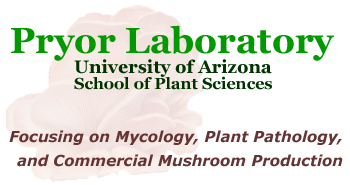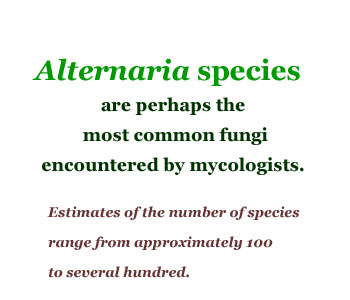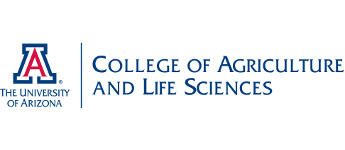Alternaria Taxonomy: Historical Perspectives

The genus Alternaria was originally described in 1816 with A. tenuis as the type and only member of the genus (Nees 1816). Diagnostic characteristics of the genus included the production in chains of dark-colored multi-celled conidia with longitudinal and transverse septa (phaeodictyospores), and a beak of tapering apical cells. Since its inception, the taxonomic status of the genus has been in flux.
In his monumental work, Systema Mycologicum, 1832, Fries did not recognize Nees' description of A. tenuis, and cited Nees' species as a synonym of Torula alternata. Moreover, Fries erected a new genus, Macrosporium, which included several species that shared phaeodictyosporic characters with Alternaria and are now currently recognized as Alternaria species, most notably M. tenuissima and M. cheiranthi (syn. A. tenuissima and A. cheiranthi, respectively). Due to this early taxonomic dissension, subsequently identified phaeodictyosporic fungi were assigned to both Alternaria and Macrosporium and no clear consensus emerged for over 100 years.
Throughout much of this period, numerous "atypical" Alternaria and Macrosporium species were described that did not produce conidia in chains and/or have a conidium beak. Moreover, two additional genera were erected,Stemphylium and Ulocladium, which also were characterized by the production of phaeodictyospores, further complicating the taxonomic resolution of this group of fungi.
The escalating confusion over the taxonomic status of these fungi prompted several re-descriptions of these genera in order to accommodate a growing list of new species (Elliot 1917, Sarcardo 1886). Due to ambiguity in Nees' original species description for A. tenuis, and Fries' erroneous generic placement of T. alternata, Keissler (1912) synonymized both A. tenuis and T. alternata with Alternaria alternata Kiessl. nov. nom. Wiltshire (1933, 1938) further proposed revised criteria for the genera Alternaria as well as the genus Stemphylium. Ulocladium was not formally recognized, Macrosporium was placed on the list of nomina ambigua, and many of the "atypical" species were placed in a subgenus of Stemphylium, Pseudostemphylium. Joly (1964) reviewed the genus Alternaria and related species, and proposed that most of these "atypical" species be classified as Alternaria rather than Pseudostemphylium.
Finally, modern concepts of these genera emerged from the work of E. G. Simmons (1967) in his seminal paper "Typification of Alternaria, Stemphylium, and Ulocladium" (Simmons 1967). Simmons reviewed Alternaria, Stemphylium, and the long-neglected genus Ulocladium, and concluded that many of the "atypical" Alternaria and Stemphylium species should be classified as Ulocladium. The historical controversy surrounding the taxonomy of these fungi is best illustrated by the fact that most "atypical" species have been placed into more than one of these genera since their initial identification [e.g., U. consortiale (Thüm.) Simmons 1967 with the synonyms M. consortiale Thümen 1876, S. consortiale (Thüm.) Groves & Skolko 1944, and A. consortiale (Thüm.) Groves & Hughes 1953.
Teleomorphs of Alternaria and Related Taxa.
Although most Alternaria species do not have known teleomorphic affinities (A. infectoria and closely related species being notable exceptions), a number of anamorphically-defined taxa within the Pleosporaceae have recognized teleomorphs, although most are not commonly encountered. More importantly, these teleomorphs are representative of nearly all major lineages within the Pleosporaceae. Most species of Stemphylium, the currently accepted sister group to Alternaria, have well established teleomorphs in the genus Pleospora.
Extensive studies by Simmons over the last 20 years have suggested an exclusive teleomorph/anamorph relationship between Pleospora and Stemphylium. Subsequently, a more critical evaluation of the teleomorphic characters of well-known Pleospora spp. with anamorphs of Alternaria, namely P. infectoria and P. scrophulariae revealed that Pleospora spp. with Stemphyliumanamorphs were morphologically distinct from Pleospora spp. with Alternaria anamorphs, particularly in the size of the ascomta and ascospores, and resulted in the designation of a new genus Lewia for Pleospora-like fungi withAlternaria teleomorphs (Simmons, 1986).
More recently, two additional anamorphic genera have been described by Simmons, Embellisia and Nimbya, and have been hypothesized as close relatives of Alternaria based upon characteristics of conidium ontogeny, morphology, and ecology. In addition, the historical taxonomy of key taxa within each genus has evolved with a level of uncertainty reminiscent of Alternaria. For example, E. allii is a well known taxon formerly known as Helminthosporium allii.
Over the past forty years, efforts to redefine the genus Helminthosporium has prompted the removal of major numbers to Drechslera and to Bipolaris (Shoemaker 1959, 1962). It was recognized that additional removal of taxa would be desirable once the appropriate affiliations were established. Simmons recognized several key traits of H. allii were inconsistent with the remaining Helminthosporium spp., and were more consistent with those of Alternaria and Ulocladium. Thus, Simmons proposed this taxon as the type member of a distinct genus Embellisia. Other species from Ulocladium and Alternaria have been added to Embellisia since. What is most interesting is that several Embellisia spp. have notable teleomorphs, including the former A. eureka. (a close relative of A. infectoria), and these teleomorphs are morphologically similar to Lewia spp. Therefore, to preserve exclusive relationships between teleomorph and anamorph, Simmons proposed that Pleosporaceae spp. with Embellisia anamorphs be considered members of a new genus Allewia.
The anamorphic genus Nimbya has followed a similar taxonomic history in that previously known taxa with atypical characters were transferred into a newly erected genus to better accommodate common characters. The type species of the genus Nimbya is the former Sporidesmium scirpicola, conidial state of Macrospora scirpicola. Although the ascomata of Macrospora are quite similar to that of Pyrenophora, the conidia are sufficiently distinct from Drechslera to be placed in a separate genus. Other authors have suggested their placement in Alternaria (Sivanesan 1984). However, Simmons believed the characteristics were sufficiently distinct from all three genera and erected the genus Nimbya to accommodate them.
Over the last 35 years, most of the critical taxonomic assessments of Alternaria and the closely related genera Stemphylium, Ulocladium, Embellisia, and Nimbya have been conducted by Simmons. Based upon the characteristics defined by Simmons (1967), Stemphylium species are readily identified on the basis of the conidiophore terminus, whereas differentiation of certain Alternaria and Ulocladium species requires a more critical examination of the basal end of immature conidia.
Species in the genus Embellisia can be differentiated based upon the distinctly pigmented septa and paucity of longisepta, and those of Nimbya can be differentiated based upon the presence of distosepta. The important morphological traits that separate species within these genera include conidium size and length/width ratio, conidium surface ornamentation, presence and length of conidium beak, conidium septation (degree and visibility), and mode of catenulation (degree and 3-dimensional sporulation pattern).
In regard to Alternaria, considering the diversity of conidium shapes and sizes among species in general, there have been efforts in developing sub-generic groupings of species based upon similar conidium characteristics. Elliot (1917) suggested that the genus could be organized into six groups based upon common conidium characteristics of length, width, and septation, with each group designated by a typical species. The need for additional groups encompassing taxa not covered in his work was clearly recognized. Neergaard (1945) proposed 3 sections for the genus based upon the formation of conidia in long chains (Longicatenatae), short chains (Brevicatenatae), or singly (Noncatenatae). Simmons (1992) expanded concepts from both Elliot and Neergaard in loosely organizing the genus into 14 species-groups based upon characteristics of conidia and catenulation.
In subsequent work with Alternaria isolates recovered from pear, Simmons and Roberts further advanced Simmons' species-group concept by referring to certain distinct groups using a representative species, for instance, the alternata group, the tenuissima group, and the infectoria group.
Additional species-groups discussed in other work include the arborescens, brassicicola, porri, and radicina groups (Roberts et al, 2000; Simmons, 1995; Pryor and Gilbertson, 1999; Pryor and Gilbertson, 2002). Although the use of species-group designation does not resolve definitive species boundaries within Alternaria, advantages of its use are that it organizes at the sub-generic level the morphologically diverse assemblage of Alternaria species and permits the generalized discussion of morphologically similar species without becoming overly restricted due to nomenclatural uncertainty. In addition, the species-group concept has provided an important framework for hypothesis-testing in advanced studies on Alternaria phylogeny. These same considerations may also apply to subgeneric grouping within related genera as well.


